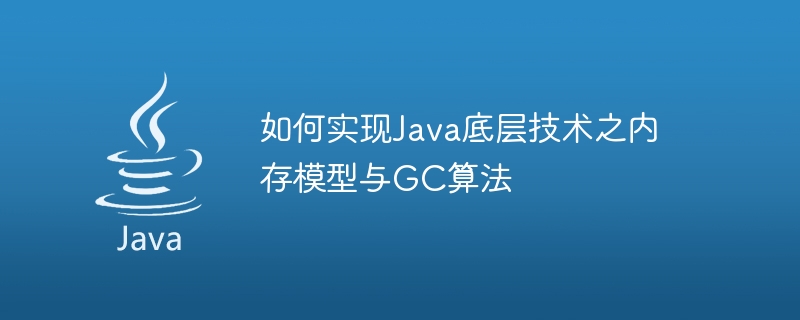Home >Java >javaTutorial >How to implement the memory model and GC algorithm of Java underlying technology
How to implement the memory model and GC algorithm of Java underlying technology
- WBOYWBOYWBOYWBOYWBOYWBOYWBOYWBOYWBOYWBOYWBOYWBOYWBOriginal
- 2023-11-08 11:55:47867browse

How to implement the memory model and GC algorithm of Java's underlying technology
Java is a cross-platform programming language, and its underlying technology includes memory model and garbage collection ( GC) algorithm. The memory model is responsible for managing memory allocation and access when the program is running, while the garbage collection algorithm is responsible for automatically reclaiming memory space that is no longer used. Understanding and implementing these underlying technologies is very important for Java developers. This article will explore the implementation of the Java memory model and GC algorithm, and provide specific code examples.
1. Java memory model
- Concepts of heap and stack
In Java programs, memory is divided into two parts: heap and stack. The heap is used to store object instances, while the stack is used to store method calls and local variables. The heap is shared memory and can be accessed by all threads, while the stack is thread-private.
- Creation and destruction of objects
Object creation in Java uses the new keyword, and object destruction is automatically completed through garbage collection. When an object is no longer referenced, the GC will mark it as recyclable. When memory is insufficient, the GC will recycle these objects that are no longer used.
- Reference types
There are four reference types in Java: Strong Reference, Weak Reference, Soft Reference and Virtual Phantom Reference. The difference in reference types determines the object's life cycle and garbage collection behavior.
2. Implementation of GC algorithm
- Reference Counting
The reference counting method is a simple garbage collection algorithm. Determine whether an object is recyclable by maintaining a reference counter on the object. When the object is referenced, the counter is incremented by 1, and when the reference is invalid, the counter is decremented by 1. When the counter reaches 0, it means that the object is no longer used and can be recycled. However, the reference counting method cannot solve the problem of circular references, and the maintenance of the counter will affect the performance of the program.
- Mark-Sweep (Mark-Sweep)
The mark-sweep method is a classic garbage collection algorithm, which is divided into two stages: mark and sweep . In the marking phase, all reachable objects are traversed starting from the root node and marked on the objects. During the cleanup phase, unmarked objects are considered unreachable and will be recycled by GC. The mark-sweep method can solve the problem of circular references, but it will cause memory fragmentation.
- Copying algorithm (Copying)
The copying algorithm divides the memory into two areas: From area and To area. During garbage collection, the surviving objects are copied from the From area to the To area, and then all objects in the From area are cleared. Copying algorithms can efficiently collect garbage, but require additional memory space. In order to solve this problem, the memory can be divided into multiple areas and use generational garbage collection.
- Mark-Compact(Mark-Compact)
The mark-compact method is an improved mark-sweep method, which will save the surviving objects during the cleanup phase. Arrange to one end of the memory and then clear the remaining memory space. The mark-and-deflate method can avoid memory fragmentation, but requires additional defragmentation operations.
Code Example:
// 创建一个对象
Person p = new Person("Tom");
// 解除对象的引用
p = null;
// 手动触发垃圾回收
System.gc();The above code snippet demonstrates how to create an object, dereference it, and then manually trigger garbage collection. The garbage collector automatically reclaims an object when it is no longer referenced.
Summary:
This article introduces the implementation of the memory model and GC algorithm of Java's underlying technology. Understanding and mastering these underlying technologies is very important for Java developers to optimize program performance and memory management. By learning the Java memory model and GC algorithm, developers can better understand the execution process of Java programs and write more efficient and reliable code. I believe that through the introduction and code examples of this article, readers can have a deeper understanding of the implementation of Java's underlying technology.
The above is the detailed content of How to implement the memory model and GC algorithm of Java underlying technology. For more information, please follow other related articles on the PHP Chinese website!

